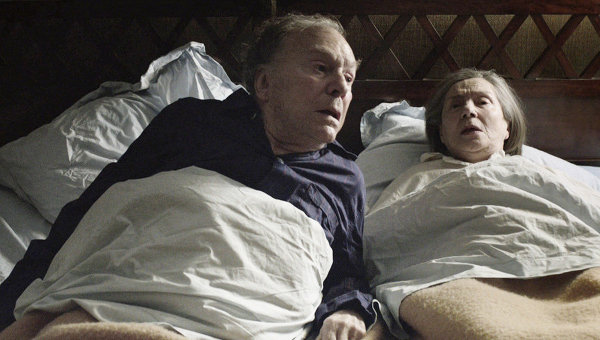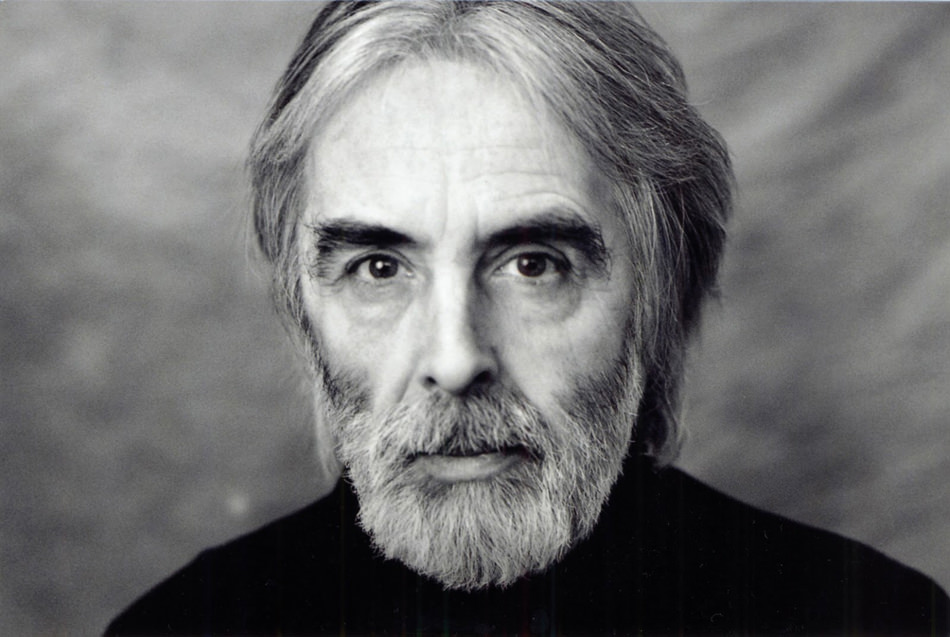Michael Haneke’s Amour is the ultimate horror film. With its portrayal of the shocks, the cruelties and indignities to which old age and disease subject a happily married Parisian couple, it’s far scarier and more disturbing than Hitchcock’s Psycho, Kubrick’s The Shining, or Polanski’s Rosemary’s Baby, and like those films, it stays with you long after you might have chosen to forget it. Like all of Haneke’s work, Amour raises interesting and perhaps unanswerable questions: Can a film be a masterpiece and still make you want to warn people not to see it? Can a movie make you think that an artist has done something extraordinary, original, extremely difficult—and yet you cannot imagine yourself uttering the words, “You’ve got to go see Amour”?
It’s hard not to appreciate the film’s extraordinary qualities. Jean-Louis Trintignant, Emmanuelle Riva, and Isabelle Huppert deliver performances so convincing and delicately nuanced that we forget they are actors, let alone French movie stars; their ability to make us think we are watching real people is partly why the film is at once so impressive and so distressing. Every camera angle seems meticulously chosen, every scene artfully composed; every detail of costume and setting—a worn bathrobe, a pair of slippers, dresses hanging in a closet, the precise way that the piano is positioned in the living room, the “good” furniture so familiar that it has become almost invisible to its owners—is appropriate to the two elderly musicians whose travails we are watching; every exchange appears to have been written and shot with perfect confidence about precisely how much to conceal or reveal.
But Amour can be excruciating to watch. The film’s narrative arc is more or less clear from the opening scene, in which we see firemen bashing their way into a handsome, high-ceilinged, old-fashioned Paris apartment. The workers are visibly disturbed by a smell that turns out to come from the corpse of an old woman: nicely dressed, comfortably positioned in bed, her hair fixed, decked with flowers, all of it conveying the odd jauntiness one sometimes observes in Sicilian catacombs. Then, the action shifts back in time. An elderly couple attends the recital of a young pianist, the wife’s former student. Returning home, Georges and Anne notice that someone has crudely and unsuccessfully tried to force open the lock on their front door.
Haneke has long been fascinated by the subject of home invasion; in his most notorious work, the 1997 Funny Games (remade a decade later in Hollywood), two vicious sadists force their way in and proceed to torture an upper-middle-class couple and their son. My favorite of his films, Caché (2005), considers the possibility that a mysterious, extended, and possibly malevolent home surveillance may be a more subtly destructive form of invasion: a highly effective psychological weapon. But Amour reminds us that the most dangerous intruders are the more common—indeed the unavoidable—ones: time and death.
One morning, over breakfast, Anne glazes over, impervious to Georges’s attempts to rouse her. She comes to, but without enough motor control to pour a cup of tea. In a characteristically masterly scene, Haneke persuades us—precisely rendering George’s initial terror, his relief, and then the alarming sight of the teapot shaking in Anne’s hand—that this is exactly how it would be if a formerly healthy loved one suddenly and helplessly sloshed tea all over the kitchen table.
An unsuccessful operation leaves Anne paralyzed on one side. The couple copes, with some difficulty, but with dignity and grace. Then Anne sustains another stroke, and the question arises of how much of her remains in the bed, drinking from a Sippy Cup and howling the same words over and over. As her mental and physical condition degenerates, we watch as the strain begins to unhinge Georges. The only break in his dreadful routine is provided by unsatisfying visits from the couple’s daughter, played by Isabelle Huppert. A musician, like her parents, the high-strung and harried Eva understandably prefers to focus on her own familiar discontents—an unfaithful husband, a troubled marriage—than to face what has become reality for her parents.
Alerted by the firemen’s break-in, we wait for the violence that we intuit will occur, though we don’t know when. And when at last it comes, it is a relief, both for the characters and the audience. That this violence is an act of love (among other emotions) may be part of what has inspired critics to talk about Amour as evidence that its director—known for his provocative, confrontational use of cinematic mayhem—has at last discovered the power of our more tender feelings. Amour, many critics have argued, is Haneke with a heart.
Advertisement
It is true that Haneke’s interest in violence has often seemed taxonomic, as if it were an element he’d discovered in a laboratory in which he’d been researching human nature and the history of the last century. Yet none of his films—however cold-blooded the depictions of murder may appear—is lacking in emotion. In one of his early works, Benny’s Video (1992), an alienated teenage boy murders a girl just to see what it’s like. Another, 71 Fragments of a Chronology of Chance (1994), culminates in the reenactment of a mass shooting that took place in an Austrian bank, and studies the inevitability with which these random killings retroactively color the hours that preceded them.
The first Haneke film I saw was The Piano Teacher (2001). I’d wondered how anyone could film Elfriede Jelinek’s vertiginously maddened rant of a novel, and while I admired the fidelity with which Haneke depicted the lethal erotic obsessions of Jelinek’s protagonist, something seemed to have been lost in shifting the setting from Austria to France; the violence in Jelinek’s fiction (like that in many of Haneke’s films) always seems partly to refer to Austria’s World War II past.
Haneke’s more recent The White Ribbon (2009), shot in black and white, set just before World War I in an isolated German village, has the frozen, mournful beauty of an August Sander portrait. An elderly narrator explains that what occurred in his town has something to do with what happened later in his country. There follows a sort of mystery in which we gradually realize who is responsible for a series of horrific crimes; by the end, we better understand what the narrator means about the relation between these events and what will follow. But, for all the cruelty it visits on the innocent along with the guilty, The White Ribbon suggests that Haneke’s vision has broadened to include the warmer aspects of human experience. The narrator of The White Ribbon—the village schoolteacher—meets a young woman who works for the local baron, and we watch the growing force of their shy attraction. One feels that, in his researches, Haneke has stumbled upon another element: love.
Amour is a love story all right, or at least the final chapter of one. In its intensity, its unflinching determination to track what happens to the dying and those around them, it recalls “The Death of Ivan Ilyich.” But while I have read Tolstoy’s story several times and expect to read it again, I can’t imagine wanting to see Amour a second time. Why would I voluntarily put myself through the awfulness of watching the scenes in which the couple struggles to navigate the suddenly staggering demands of the wheelchair, the knife and fork, the toilet?
Perhaps what distinguishes Amour from its literary counterparts is the intimacy of film. There we are, up close and personal, flies on the wall of the Paris apartment. Nothing, we feel, is being held back, nothing concealed; we are witnessing what Eva is trying so hard not to imagine. In “The Death of Ivan Ilyich,” Tolstoy also gets in very close to his characters, escorting us into the room of a dying judge who realizes he’s led his entire life wrong and screams for three days and nights. And Shakespeare puts us out on the storm-wracked hill, along with the raging, powerless Lear. But nowhere in Tolstoy or Shakespeare do we see a helpful nurse teaching the Fool or the peasant Gerasim how to change the old man’s diaper. There’s no transcendence in Amour, no comfort. In the final scene we see Eva, alone in the apartment where the smell of death still lingers and where, amid all the cherished possessions, the remnants of two full lives, there is nothing but a wrenching sense of loss and absence.
Haneke suggests yet another question: Is it possible to be, simultaneously, a sadist and a moralist? The insistence with which he obliges us to witness every stage of Anne’s decline is in itself cruel, even merciless. Yet he almost manages to formulate a harsh critique of Europe’s failure to come to terms with the needs of its aging population; Georges’s plight, we feel, might not be quite so dire were he given other choices besides putting Anne in a home or hiring private nurses, one of whom he fires (in an especially disturbing scene) for incompetence. And the film will doubtless fuel the continuing debate over euthanasia. Under what circumstances can murder be, as it appears to be here, the ultimate expression of love?
Advertisement
Amour evokes the apostles and saints pictured in medieval and Renaissance art with skulls on their writing desks, as well as the monks who, in James Joyce’s “The Dead,” are said to sleep in their coffins “to remind them of their last end.” Michael Haneke is to be praised and admired for filming—so beautifully and so truthfully—straight down into the abyss, and for inviting us to take a long hard look at what’s there. The experience (and the courage required) is impressive, but the view is so unrelentingly brutal that we may well wonder why we are seeing it sooner than we have to.




